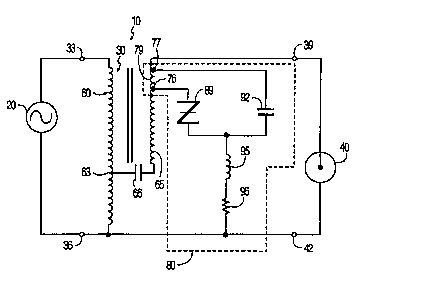Une partie des informations de ce site Web a été fournie par des sources externes. Le gouvernement du Canada n'assume aucune responsabilité concernant la précision, l'actualité ou la fiabilité des informations fournies par les sources externes. Les utilisateurs qui désirent employer cette information devraient consulter directement la source des informations. Le contenu fourni par les sources externes n'est pas assujetti aux exigences sur les langues officielles, la protection des renseignements personnels et l'accessibilité.
L'apparition de différences dans le texte et l'image des Revendications et de l'Abrégé dépend du moment auquel le document est publié. Les textes des Revendications et de l'Abrégé sont affichés :
| (12) Demande de brevet: | (11) CA 2187218 |
|---|---|
| (54) Titre français: | SYSTEME DE CIRCUIT POUR L'ALLUMAGE D'UNE LAMPE A DECHARGE HAUTE INTENSITE |
| (54) Titre anglais: | CIRCUIT ARRANGEMENT FOR IGNITION OF A HIGH INTENSITY DISCHARGE LAMP |
| Statut: | Réputée abandonnée et au-delà du délai pour le rétablissement - en attente de la réponse à l’avis de communication rejetée |
| (51) Classification internationale des brevets (CIB): |
|
|---|---|
| (72) Inventeurs : |
|
| (73) Titulaires : |
|
| (71) Demandeurs : |
|
| (74) Agent: | SMART & BIGGAR LP |
| (74) Co-agent: | |
| (45) Délivré: | |
| (86) Date de dépôt PCT: | 1996-01-23 |
| (87) Mise à la disponibilité du public: | 1996-08-15 |
| Licence disponible: | S.O. |
| Cédé au domaine public: | S.O. |
| (25) Langue des documents déposés: | Anglais |
| Traité de coopération en matière de brevets (PCT): | Oui |
|---|---|
| (86) Numéro de la demande PCT: | PCT/IB1996/000051 |
| (87) Numéro de publication internationale PCT: | WO 1996025022 |
| (85) Entrée nationale: | 1996-10-04 |
| (30) Données de priorité de la demande: | ||||||
|---|---|---|---|---|---|---|
|
L'invention concerne un système de circuit pour allumer une lampe à décharge haute intensité sous la forme d'impulsions d'allumage fournies à la lampe avant et sensiblement pendant toute la durée d'incandescence de la lampe. L'allumeur présent dans le circuit comprend un dispositif bilatéral de commutation du type SIDAC ayant une tension d'amorçage correspondant à la tension de la lampe lorsque la lampe est en mode d'incandescence. Le système de circuit évite sensiblement que la lampe reste dans son mode incandescent pendant une durée de temps prolongée, ce qui minimise la possibilité d'une destruction de la lampe consécutive à une détérioration des électrodes de la lampe.
The invention concerns a circuit arrangement for starting a high intensity discharge lamp requiring energy in the form of ignition
pulses being provided to the lamp prior to and substantially throughout the glow load of the lamp. An ignitor comprised by the circuit
arrangement includes a bilateral switching device such as, but not limited to, a SIDAC having a breakover voltage corresponding to the
lamp voltage during the lamp glow mode. The circuit arrangement substantially eliminates the lamp remaining in its glow mode for a
prolonged period of time thereby minimizing the possibility of lamp destruction from damage to the lamp electrodes.
Note : Les revendications sont présentées dans la langue officielle dans laquelle elles ont été soumises.
Note : Les descriptions sont présentées dans la langue officielle dans laquelle elles ont été soumises.

2024-08-01 : Dans le cadre de la transition vers les Brevets de nouvelle génération (BNG), la base de données sur les brevets canadiens (BDBC) contient désormais un Historique d'événement plus détaillé, qui reproduit le Journal des événements de notre nouvelle solution interne.
Veuillez noter que les événements débutant par « Inactive : » se réfèrent à des événements qui ne sont plus utilisés dans notre nouvelle solution interne.
Pour une meilleure compréhension de l'état de la demande ou brevet qui figure sur cette page, la rubrique Mise en garde , et les descriptions de Brevet , Historique d'événement , Taxes périodiques et Historique des paiements devraient être consultées.
| Description | Date |
|---|---|
| Le délai pour l'annulation est expiré | 2004-01-23 |
| Demande non rétablie avant l'échéance | 2004-01-23 |
| Réputée abandonnée - omission de répondre à un avis sur les taxes pour le maintien en état | 2003-01-23 |
| Inactive : Abandon.-RE+surtaxe impayées-Corr envoyée | 2003-01-23 |
| Demande publiée (accessible au public) | 1996-08-15 |
| Date d'abandonnement | Raison | Date de rétablissement |
|---|---|---|
| 2003-01-23 |
Le dernier paiement a été reçu le 2001-12-13
Avis : Si le paiement en totalité n'a pas été reçu au plus tard à la date indiquée, une taxe supplémentaire peut être imposée, soit une des taxes suivantes :
Veuillez vous référer à la page web des taxes sur les brevets de l'OPIC pour voir tous les montants actuels des taxes.
| Type de taxes | Anniversaire | Échéance | Date payée |
|---|---|---|---|
| TM (demande, 2e anniv.) - générale | 02 | 1998-01-23 | 1998-01-06 |
| Enregistrement d'un document | 1998-08-05 | ||
| TM (demande, 3e anniv.) - générale | 03 | 1999-01-25 | 1998-12-09 |
| TM (demande, 4e anniv.) - générale | 04 | 2000-01-24 | 1999-12-07 |
| TM (demande, 5e anniv.) - générale | 05 | 2001-01-23 | 2000-12-06 |
| TM (demande, 6e anniv.) - générale | 06 | 2002-01-23 | 2001-12-13 |
Les titulaires actuels et antérieures au dossier sont affichés en ordre alphabétique.
| Titulaires actuels au dossier |
|---|
| KONINKLIJKE PHILIPS ELECTRONICS N.V. |
| Titulaires antérieures au dossier |
|---|
| ALLAN E. BROWN |